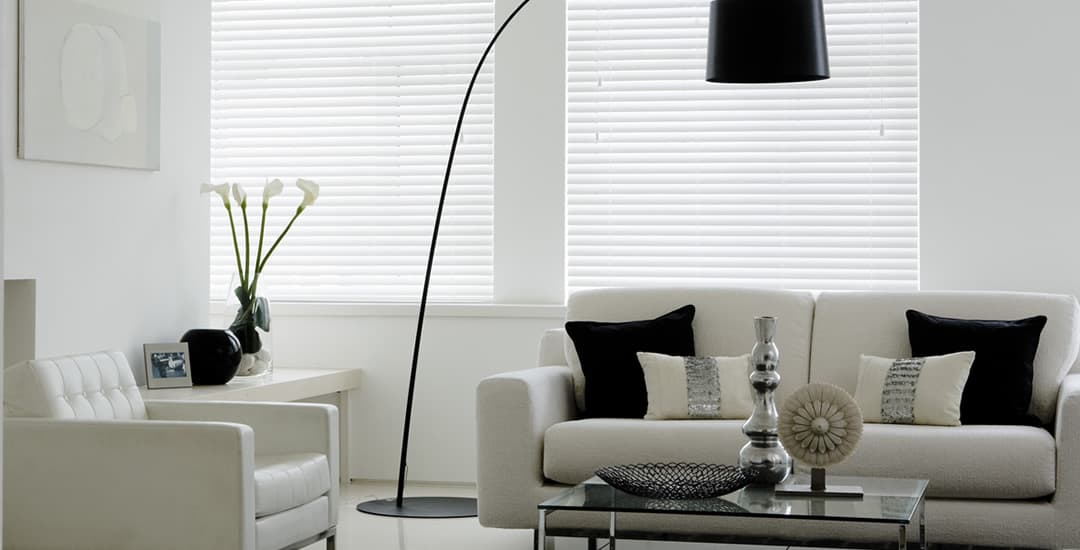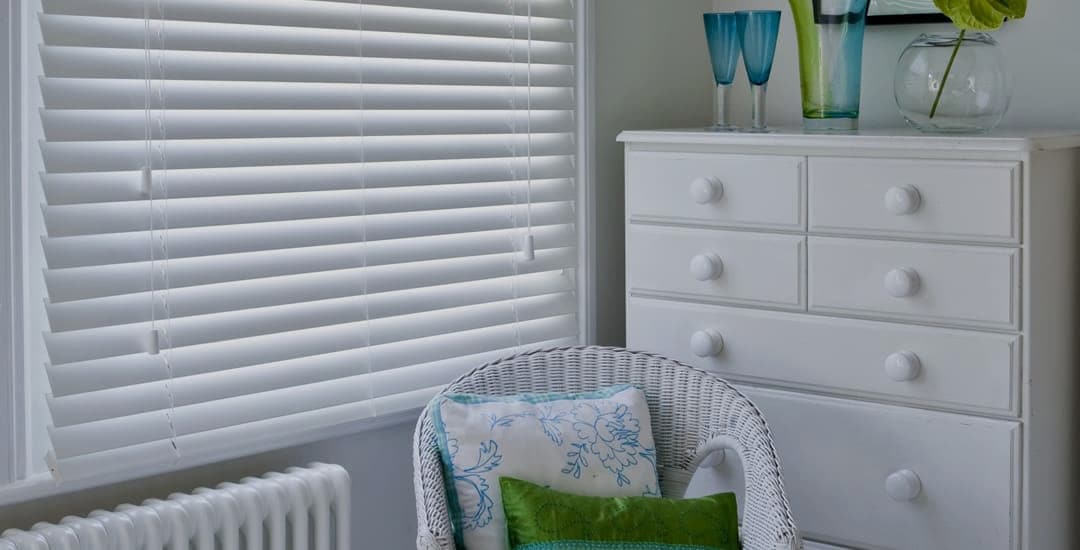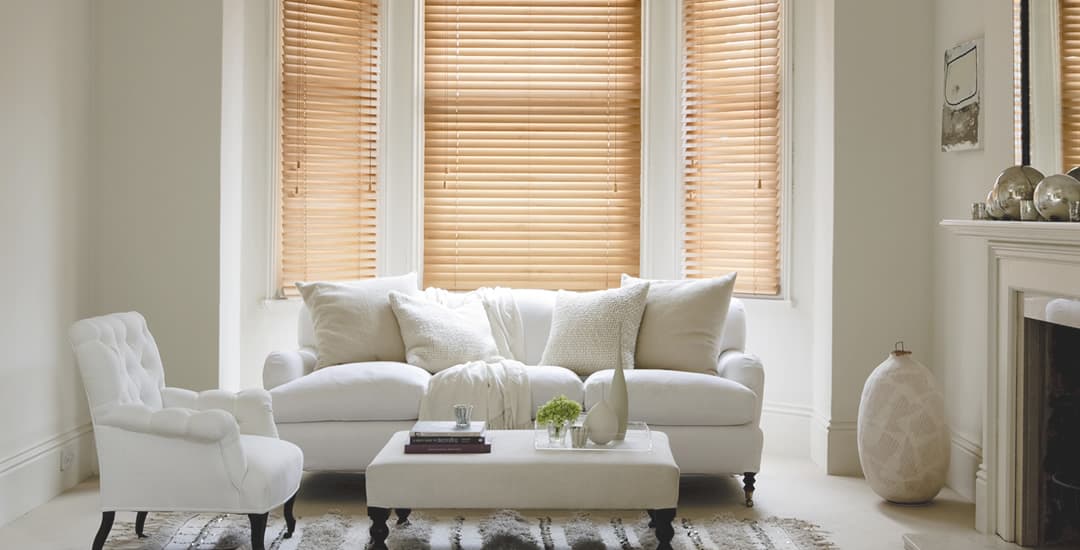
No. You can’t see through faux wood blinds when they’re fully closed, in 99.5% of cases. Even in those remaining 0.5% of cases, you can’t see anything worth seeing, if you will.
We get a lot of questions about what can be seen through faux wood blinds in various different scenarios; which, if you haven’t faced any of them, might seem a bit Midvale School for the Gifted, because faux wood blinds are made of a solid material that itself blocks out virtually all external light and so, by design, also eyes. Right?
Yes.
But. Faux wood blinds aren’t welded to the window (or whatever the welding equivalent for rigid PVC materials is – melted to the window?) which means that they have four sides with potential gaps where they meet or overlap the wall, and also, the slats themselves don’t form a hermetic seal either, which is why I say that they block “virtually” all external light. Oh, also, eyes.
This blog post will provide a rather more sensible answer to a number of hypothetical questions about what people outside could see of people inside if faux wood blinds were on guard, including:
- Can you see through faux wood blinds at night when you’ve got your internal lights on? (No.)
- Can you see through faux wood blinds if their slats are closed downwards? (No or more to the point, no in every meaningful sense of the word.)
- Can you see through faux-wood blinds if you peep down the sides of them? (Depends on how big the gap is between blind and window; lookin’ at you, poorly fitting readymade blinds.)
- Can you see through faux wood blinds in bay windows where the blinds abut each other? (depends on the gap/spacing etc., but for most functional purposes, no.)
- Can you see through faux wood blinds if the blind is open? (Just checking who is still awake at this point.)
Right then. Let’s roll!
Can you see through faux wood blinds at night?
No, you can’t see through faux wood blinds at night. If you were outside in the dark and there were lights on inside behind the blinds, you’d possibly be able to see some diffuse light leakage around the slats and at the sides, but that’s your lot.
Can you see through faux-wood blinds if they’re closed downwards?

If you’re giving this question the Scooby Doo face, you’re not alone. I didn’t realise for ages that there are people out there who close their blinds upwards at all so that the slats lie the wrong way – nor that said people might in fact consider my way (the right way) to be the wrong way in turn.
I’m kind of maybe misusing my authority position as That Woman from the Blinds Company Who Knows Stuff to push the opinion that my way of closing blinds (downwards) is the right way and that those swimming against the tide are wrong; there is no actual right or wrong.
Much as I’ve tried telling my bosses that we should have people undergo a home check and fill out a form before we approve them to provide a home for one of our blinds, said bosses keep telling me that this is not a thing and that once the blinds have left the workshop, they’re not ours anymore and people can open and close them however they want, and that yes ok Polly you can leave early, just please stop talking.
Anyway. Closing your slatty blinds downwards rather than upwards (see this blog post/pic if you’re not following what I mean) is the norm for the vast majority of people, because they, like me, think that closing a blind upwards is somewhat akin to rubbing a cat’s fur the wrong way, albeit less likely to result in biting.
However. When it comes to blinds with the slats closed downwards, if someone outside got their face pressed right against the window and looked down through the slats, they might potentially be able to see… About 1” of windowsill/carpet/whatever lies directly below the blind at that slat angle.
So, if there’s someone out there whose life depends on knowing what you have on your windowsill or the colour of your carpet and your life in turn depends on stopping them, maybe don’t close your faux wood blind slats in the downward position if they’re at or below ground level and someone could get up close and look in through them from above.
Everyone else is good though.
Can you see through faux-wood blinds from the sides?

No, not if you buy made to measure blinds from a supersonic British window blinds company like us, and your measurements when ordering were sound. This is because a blind that’s custom made to fit the window and then installed properly won’t have any gaps at the sides for anyone to see in through.
However, if you bought a readymade faux wood blind and it is a shade too small for the window or otherwise isn’t an exact fit, then yes, people might be able to see down the sides of the blind. The larger the gap between blind and wall, the wider/better their angle of vision will be.
The same applies if you’re using two faux wood blinds side by side to cover a very large window, and you chose readymade blinds that are not an exact fit and don’t abut each other seamlessly but instead leave a little gap between them.
Can you see through faux wood blinds in bay windows?

No, or not in most cases and even then, not in any meaningful way. If this is rather less of a hard “no” than you were looking for, I suggest you check out my really exciting novel-length epic guide to bay window blinds, (which I have divided into chapters so that you can skip directly to the relevant part and don’t need to read the whole thing unless you get detention).
If you’d rather eat your own eyes than do that even after I sold it so well, here’s the short version/the version that might help you to determine if you should, in fact, follow that link:
If your bay window has particularly narrow mullions, depending on the angle of the windows and so, how your blinds butt up against each other, this might potentially leave small gaps that would allow someone standing directly in the flowerbed under the window a very narrow angle of vision into the room (that cannot in this instance be blamed on the blind necessarily being readymade).
Oh, and in my guide to buying blinds for bay windows, I’ll tell you what mullions are too. Run, don’t walk…




